

Palazzo Comunale (1273)
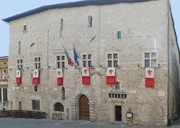
In 1273, the Podestà, Alberto da Montebono and the Capitano del Popolo, Giacomo da Massa appointed an official called Berrettino to buy three tower houses in the parish of San Salvato (in what is now Piazza dei Priori). These properties, which had belonged (respectively) to the Sinibaldi, Oddone and Omodei families, were incorporated to form the present palace.
The windows in the first floor and the Renaissance portal were added in 1427.

Nine inscriptions on the facade (starting with these three to the left) record some of the cardinal protectors of Narni in the 16th-18th centuries:
-
✴Carlo Maria Sacripante (died 1758);
-
✴Giuseppe Sacripante (died 1727);
-
✴Pierdonato Cesi, the younger (died 1656);
-
✴Pierdonato Cesi, the elder (died 1586);
-
✴Federico Cesi (died 1565);
-
✴Bartolomeo di Angelo Cesi (died 1621);
-
✴Giovanni Bernardino Scotti (died 1568);
-
✴Giuseppe Renato Imperiali (died 1737); and
-
✴Giuseppe Castelli (died 1780).
Loggia
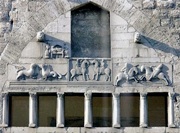
The portal to the right belonged to the Cappella del SS Salvatore, which was built as a substitute for the nearby church of San Salvato, which was demolished in 1495. The columns of the elegant loggia above the portal and the reliefs (13th century) above it came from this church.



-
✴The reliefs in the frieze depict:
-
•a lion fighting a griffin;
-
•a hunting scene; and
-
•two knights in combat.
-
✴The relief above them (to the left of the tabernacle) depicts Judith holding the head of Holofernes, and the sword with which she has just beheaded him.

[Fresco (16th century) of Salvator Mundi inside is attributed to Bartolomeo Torresani]
Atrium
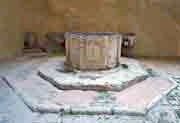
The vaults of the atrium are supported by a single central arch. The well at its centre dates to the 15th century.
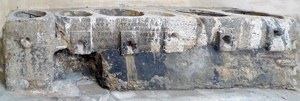
The travertine block containing six holes, which is along the wall behind the well, is dated by inscription to 1597. The holes were used for measuring quantities of grain.
Until recently, the atrium housed part of the civic collection, most of which is now in Palazzo Eroli. However, two items from the collection were still here at the time of my visit in 2010:
-
✴The collection of blocks on the back wall came from a tomb of uncertain date that was discovered “ad narem flumen” (near the river Nera) in 1930. The inscription recording its discovery uses Fascist dating: “anno VIII a fascibus receptis” (year 8 of the new era), which means eight years after Mussolini’s rise to power in 1922.

-
✴This travertine relief (10th century?) of the symbol of St Mark, which is also on the back wall, is of unknown provenance.

The staircase in the atrium leads to the Sala del Consiglio. [Doorway inscribed “Mons Pietatis” - Monte di Pietà]
Sala del Consiglio
Stigmatisation of St Francis (1500)
This detached fresco on the back wall of the the Sala del Consiglio, which is dated in the inscription, came from the Observant Franciscans' Convento di San Girolamo and is by a follower of Giovanni di Pietro, lo Spagna.
Palazzo dei Priori (14th century)
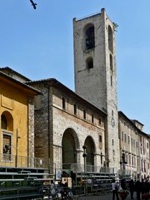
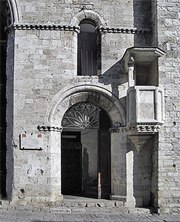
The present palace stands next to the Torre Civica (13th century).
The two huge vaults of the loggia, together with the portal and the Loggetta del Banditore between the right arch and the Torre Civica (illustrated in detail above, to the right), belong to the original palace, which is attributed to Matteo di Giovannello, il Gattapone. The presence of the Orsini arms [above the central pilaster of the loggia or on the facade?] suggests that it was commissioned in 1373-7, when the Orsini held Narni for the papacy.
The upper storey was added in the 15th century.
An inscription inside the loggia documents an intervention by Pope Paul III in 1546.
The iron rings on the central pillar were used as a public pillory.
Scuole Pie di San Cassio (1618-1885)
St Joseph Calasanz, the founder of the Ordinis Scholarum Piarum, a religious order dedicated to the provision of free education, founded a school here in 1618. This was the second school belonging to the order: the first had been established in Rome in 1597.
The school survived the suppression of religious orders in 1866, but closed in 1885.

